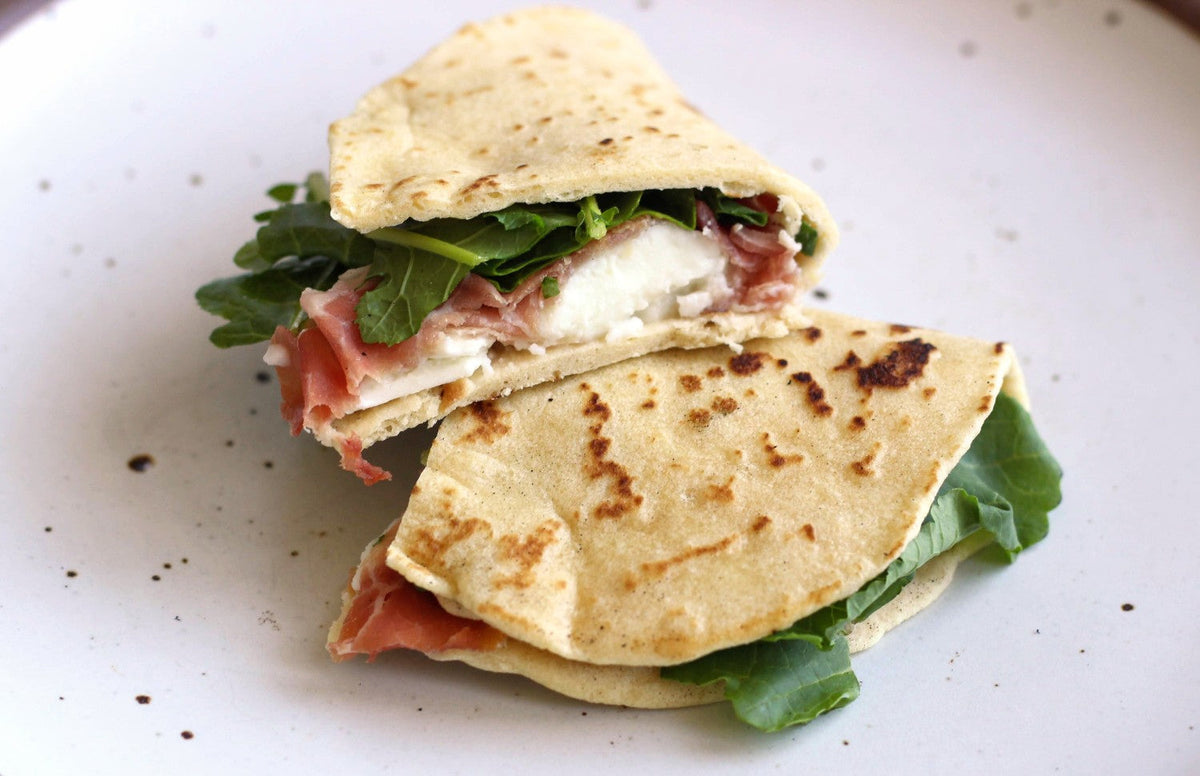
Piadina Romagnola
|
|
Time to read 4 min
|
|
Time to read 4 min
The first time I traveled south from Bologna – firmly planted in the Emilia half of Emilia-Romagna – to my friend’s home in Rimini, a seaside town in Romagna, she told me we could stop to grab a piadina for lunch. I had never heard of piadina before, despite my time in Bologna – how could it be? We stopped at a nondescript roadside kiosk with a few plastic chairs, where a single lady flipped flat, round breads one after the other on a piping hot griddle. (Like any good American, I would be lying if I said I didn’t fall for their pancake-ness right then and there.) One bite of this hot-off-the-press flatbread filled with prosciutto crudo, squacquerone (a soft, tangy cheese), and arugula, and I knew I was hooked on piadina forever.
Piadina, or piada, is an Italian flatbread made with flour, lard or olive oil, salt, and baking soda. It’s typical of the Emilia-Romagna region and is most often served filled with cured meats, cheese, and vegetables and folded in half for a perfect handheld sandwich. In the heart of Romagna on the Adriatic coast, you’ll find piadina on the table with nearly every meal, often in place of bread.
As with most Italian recipes, even a flatbread is not just a flatbread. In fact, as you travel down the coast from Ravenna to Rimini, you’ll find that the piadina gets thinner and thinner the farther south you go. Each town boasts its preferred thickness, from the fluffy, tall piada of Ravenna – one of these will keep your belly full for hours – to the thin, wide version found at the Rimini seaside, where piada is the street food of choice – even at the beach!
As with most cucina povera traditions, this Italian staple makes use of the cast-off bits – in this case, lard – and takes all of 30 minutes to throw together.

30 minutes
30 minutes
3
250 grams (2 cups) 00 flour*
35 grams (2 ¾ tablespoons) lard or olive oil, room temperature
7 grams (1 ¼ teaspoons) kosher salt
1.5 grams (¼ teaspoon) baking soda
Roughly 85 grams (6 tablespoons) of water, or as much as needed, room temperature
*Double zero (00) flour is a finely milled soft wheat flour popular in Italy. You may also use all-purpose, although the texture might not be as delicate. If you want to make your piadina a little heartier, try mixing in some whole wheat flour!
Add lard to the middle of the well and start to incorporate it into the flour mixture using your fingertips. Continue to combine until the dough is dry and crumbly and there are no large pieces of lard.
Once again, form a well in the flour and lard mixture. Slowly pour in water, starting with small increments. Mix together until the dough starts to come together and form a ball. If the dough feels too dry, add more water. If it starts to feel too sticky, add a bit more flour.
Knead the dough until smooth and evenly colored, about five minutes. Divide the dough into three equal portions, weighing about 120 grams each. Shape each piece into a round disc. Cover each disc in plastic wrap and let rest for 30 minutes.
Meanwhile, heat a cast-iron pan or griddle over medium to high heat. The pan should be super hot before you start cooking, so you can get those coveted seared spots that make the piadina so good! Cook each piadina on the hot griddle or pan for a little under a minute per side, just until golden in color. As it cooks, prick any bubbles that start to form with a fork or the tip of a sharp knife.
Once the piadina is done, set-aside and cover with a kitchen towel to keep warm.
You can also serve piadina for dessert with Nutella – or you know, right as you flip one fresh off the griddle (is there anything better?).
